![]()
![]()
![]()
Use LEFT and RIGHT arrow keys to navigate between flashcards;
Use UP and DOWN arrow keys to flip the card;
H to show hint;
A reads text to speech;
19 Cards in this Set
- Front
- Back
|
In what direction is the slice select gradient for the following image planes applied:
Axial Sagittal Coronal |
Axial: Z gradient
Sagital: X gradient Coronal: Y gradient |
|
|
What are the components of a spin echo sequence?
|
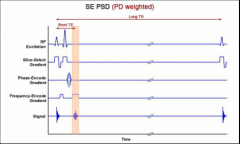
1) RF excitation pulse tips longitudinal magnetiation into transverse plane
2) Phase and frequency gradient pulses codify spatial location in selected slice 3) The spin dephase for a short time TE/2 followed by a 180 RF pulse which rephases spin at TE 4) Repeat for each line of K-space Increase TR reduces T1 contrast Increasing TE increases T2 Contrast |
|
|
Why do we apply a 180 RF pulse?
|
To rephase spins which decay more rapidly than expected due to field inhomogeneity
What's the problem: Long TR therefor slow |
|
|
What is a typical TR (msec) and TE for a T1 weighted sequence?
|
TR: 500
TE: 20 |
|
|
What are typical TR and TE for a proton density sequence?
|
TR: 2000
TE: 20 |
|
|
What are typical TR and TE for T2 weighted sequences?
|
TR: 2000
TE: 80 |
|
|
How does fast spin echo work?
|
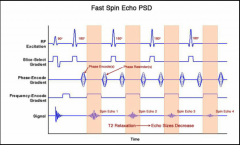
1) RF excitation pule
2) A train of echoes occurs 3) Each echo fills one row of k-space Decreases total scan time at expense of T2 blurring: the transverse magnetic signal gradually decreases for each line of the echo train. Phase rewinding gradients are applied to minimize the decay between echoes This sequence is good to minimize magnetic susceptibility and inhomogeneity |
|
|
How does gradient echo work?
|
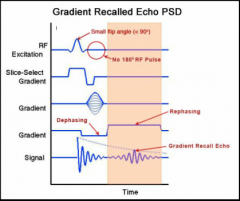
1)SMALL (<90 degree) excitation pulse creates SOME transverse magnetization
2) Phase and frequency gradients applied to codify the patial location 3) A negative frequency gradient is applied and causes rapid dephasing 4) A positive frequency gradient rephases transverse magnetization producing "gradient" echo at TE Sensitive to field inhomogeneity and magnetic susceptibillity (opposite of FSE) Short TR (Fast sequence) Less heat to tissue Good for imaging hemorrhage Decreased SNR |
|
|
GRE produces what types of sequences?
|
T2*, T1 and mixed weighted images (T1/T2* and T2/T1) depending on flip angle
|
|
|
What is spoiled GRE?
|
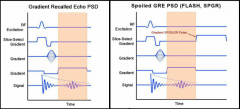
GRE with a spoiler gradient that destroys any transverse magnetization remainging after each echo
Much faster but limited to inherently T1 weighted sequence (short TR) |
|
|
What is fast spoiled GRE?
|
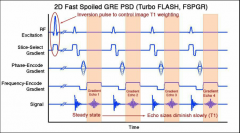
Spoiled GRE + dephasing and rephasing gradients to generate echo trains (like FSE) to fill multiple rows of K space at a time.
Very fast high resolution T1 weighted imaging |
|
|
What is Coherent GRE?
|
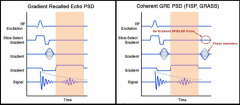
GRE + phase rewinders (no spoiler gradient) to cause a steady state mixture of longitudinal and transverse magnetization
T1, T2 (T1/T2*) |
|
|
What is balanced coherent GRE?
|
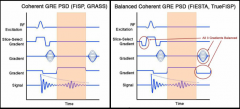
(FIESTA) All three gradients are balanced such that dephasing of spins is compensated by an equal rephasing of spins
T2/T1 image contrast good contrast between blood and muscle (cardiac imaging) |
|
|
What is echo planar imaging?
|
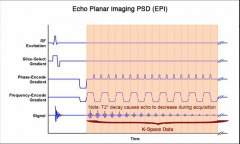
Frequency encode gradient cycles continuously
reduced image matrix superfast T2 weighted THIS IS THE DWI |
|
|
What is inversion recovery spin Echo?
|
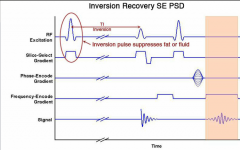
A 180 degree RF pulse inverts tissue magnetization which recover at different rates. A standard spin echo acquisition sequence is then performed.
The 180 degree pulse is given before the 90 degree excitation pulse. By varying the invertion time (TI) different tissues can be supressed. Can be done for T1 and T2 weighted sequences Fat suppression (STIR: Short tau Inversin Recovery) Fluid suppression ( FLAIR: Fluid attenuation Inversion recovery) Much less susceptibility to magnetic field inhomogeneity and magnetic susceptibilities |
|
|
What is inversion recovery GRE?
|
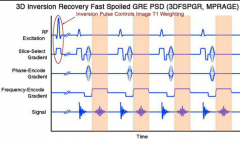
Same idea as before but with GRE
Superfast high resolution T1 weighted imaging with fat suppression |
|
|
How does 3D MRI technique work?
|
A slab is selected with the first slice select
A second slice select is used to cut the slab into slices. All slices undergo excitation and detection at the same time. Benefits: thinner slices (isovolumetric voxels) higher signal to noise Problems: GRE based, susceptible to magnetic field inhomogeneity and magnetic susceptibilities Artifact prone Acquisition time proportional to TR x Np x NEX x S Np= number of phase encodes NEX = number of excitations or averages S= number of slices |
|
|
How about 2D MRI?
|
Acquisition time proportional to TR x Np x NEX
Np= number of phase encodes NEX = number of excitations or averages |
|
|
Factors affecting acquisition times
|
Echo train length (echo trains enable fewer number of phase encodes which speed up scanning)
Parallel imagaing acceleration factor: multiple coils = more images in same time Rectangular FOV: Anatomic coverage reduced in phase encode direction which reduces Np |

